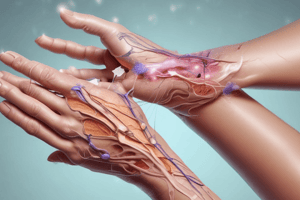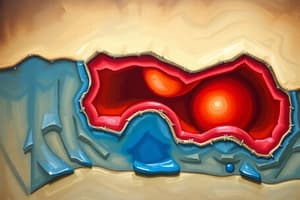Podcast
Questions and Answers
Wound healing is solely a cellular process, with no molecular components involved.
Wound healing is solely a cellular process, with no molecular components involved.
False (B)
Which of the following is NOT a key factor influencing wound healing?
Which of the following is NOT a key factor influencing wound healing?
What are three important aspects of wound assessment?
What are three important aspects of wound assessment?
Location, size, depth, and shape; wound bed characteristics; surrounding skin condition.
Thorough wound cleaning is essential to remove debris and promote ______.
Thorough wound cleaning is essential to remove debris and promote ______.
Signup and view all the answers
Match the wound debridement technique with its description:
Match the wound debridement technique with its description:
Signup and view all the answers
Which type of wound dressing is known for its ability to absorb exudate and maintain a moist environment?
Which type of wound dressing is known for its ability to absorb exudate and maintain a moist environment?
Signup and view all the answers
Which of the following is NOT a primary intention of wound closure?
Which of the following is NOT a primary intention of wound closure?
Signup and view all the answers
The choice of wound closure method depends on ______ and patient factors.
The choice of wound closure method depends on ______ and patient factors.
Signup and view all the answers
What are two examples of wound closure methods?
What are two examples of wound closure methods?
Signup and view all the answers
Wound cultures are not essential for identifying the causative organisms of an infection.
Wound cultures are not essential for identifying the causative organisms of an infection.
Signup and view all the answers
What is the primary factor influencing the choice and duration of antibiotic therapy for wound infections?
What is the primary factor influencing the choice and duration of antibiotic therapy for wound infections?
Signup and view all the answers
Patients requiring increased protein, vitamin, and mineral needs for wound healing may benefit from ______.
Patients requiring increased protein, vitamin, and mineral needs for wound healing may benefit from ______.
Signup and view all the answers
Match the following wound care procedures to their primary focus:
Match the following wound care procedures to their primary focus:
Signup and view all the answers
Which of these is NOT a contributing factor to chronic wound development?
Which of these is NOT a contributing factor to chronic wound development?
Signup and view all the answers
Understanding the etiology of chronic wounds is not crucial in developing an effective treatment plan.
Understanding the etiology of chronic wounds is not crucial in developing an effective treatment plan.
Signup and view all the answers
What is the importance of patient education in wound care?
What is the importance of patient education in wound care?
Signup and view all the answers
Flashcards
Secondary intention
Secondary intention
Wound healing from the bottom up, allowing granulation tissue.
Tertiary intention
Tertiary intention
Delayed closure after initial inflammation and infection resolves.
Infection control
Infection control
Methods to prevent and manage infection in wounds.
Nutritional support
Nutritional support
Signup and view all the flashcards
Pain management
Pain management
Signup and view all the flashcards
Patient education
Patient education
Signup and view all the flashcards
Specialized wound care
Specialized wound care
Signup and view all the flashcards
Chronic wound management
Chronic wound management
Signup and view all the flashcards
Wound Healing
Wound Healing
Signup and view all the flashcards
Factors Influencing Healing
Factors Influencing Healing
Signup and view all the flashcards
Wound Assessment
Wound Assessment
Signup and view all the flashcards
Signs of Infection
Signs of Infection
Signup and view all the flashcards
Wound Cleansing
Wound Cleansing
Signup and view all the flashcards
Debridement
Debridement
Signup and view all the flashcards
Types of Dressings
Types of Dressings
Signup and view all the flashcards
Wound Closure Methods
Wound Closure Methods
Signup and view all the flashcards
Study Notes
Principles of Wound Management
- Wound healing is a complex interplay of cellular and molecular processes.
- Wound management aims to optimize the environment for healing, promoting tissue regeneration and minimizing complications.
- Key factors impacting wound healing include: blood supply, tissue type, infection, nutrition, age, medications, and systemic diseases.
- Effective wound care hinges on thorough assessment of the wound: location, size, depth, shape; wound bed characteristics (necrotic tissue, exudate, granulation tissue); surrounding skin condition; and patient's medical history and current medications.
Wound Assessment
- Clinical assessment is crucial for appropriate wound management.
- Assess for infection signs: redness, swelling, pain, heat, purulent drainage.
- Evaluate for foreign bodies (sutures) or devitalized tissue/eschar.
- Determine exudate amount and type (serous, purulent, sanguineous).
- Identify undermining or tunneling.
- Precise documentation tracks wound progress and treatment adjustments.
Wound Cleansing
- Thorough cleansing removes debris, promoting healing.
- Methods include irrigation and debridement.
- Avoid harsh chemicals that may damage or irritate tissues.
- Aseptic technique prevents infection.
- Sterile saline or appropriate solutions are commonly used for irrigation.
Wound Debridement
- Debridement removes non-viable tissue to reveal healthy tissue.
- Techniques include mechanical (e.g., wet-to-dry dressings), enzymatic, autolytic, and surgical debridement.
- Appropriate debridement selection depends on wound characteristics and patient condition.
Wound Dressings
- Dressings protect the wound, absorb exudate, and maintain a moist environment.
- Dressing choice depends on wound type, exudate amount, and desired environment.
- Common dressing types include hydrocolloids, hydrogels, alginates, foams, and films.
- Aseptic application and removal prevents contamination and injury.
- Optimizing the wound environment is critical for healing and reducing infection risk.
Wound Closure
- Closure methods depend on wound size, depth, and patient factors.
- Primary intention involves direct closure of wound edges.
- Secondary intention allows healing from the bottom up.
- Tertiary intention delays closure after initial inflammation and infection resolve.
- Appropriate sutures and dressings support closed wounds.
Infection control
- Infection is a common wound complication.
- Strict aseptic technique is essential in all wound care procedures.
- Wound cultures may identify causative organisms and guide antibiotic therapy.
- Appropriate antibiotic use effectively combats infection.
- Clinicians should guide antibiotic choice and duration based on clinical judgment and lab results.
Nutritional Support
- Adequate nutrition is vital for wound healing.
- Patients may require nutritional supplements for increased protein, vitamin, and mineral needs.
- Identifying nutritional deficiencies maximizes healing potential.
Pain Management
- Pain management is crucial for patient comfort and treatment adherence.
- Pain assessment and appropriate analgesic therapy are essential in wound care.
Patient Education
- Patient education is critical for successful home wound management.
- Instructions on wound care techniques, infection signs, and follow-up appointments ensure optimal outcomes.
- Clear and accessible information facilitates successful self-care.
Specialized Wound Care
- Specialized care is often needed for unique wounds like pressure ulcers, diabetic ulcers, or surgical wounds, involving specialized dressings and treatments.
- Managing chronic wounds requires a comprehensive patient-centered approach, considering comorbidities, vascular issues, neurological deficits, mechanical factors, and adherence to therapy.
- Understanding the etiology of chronic wounds directs a targeted treatment plan addressing underlying causes and proper wound management techniques.
Studying That Suits You
Use AI to generate personalized quizzes and flashcards to suit your learning preferences.
Description
This quiz covers the principles of wound management, including the biological processes involved in wound healing and the factors that affect it. It emphasizes the importance of thorough wound assessment for optimal healing outcomes. Key considerations include patient history, signs of infection, and wound characteristics.




